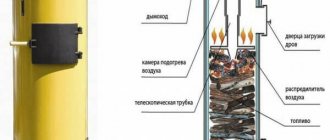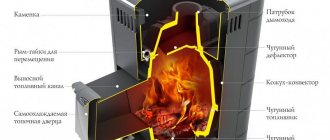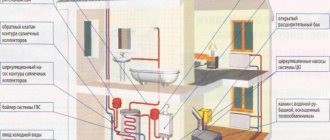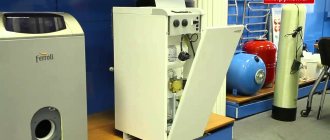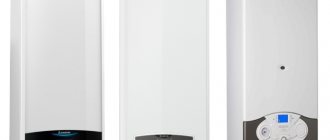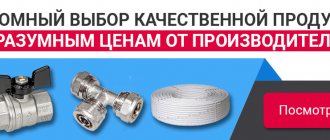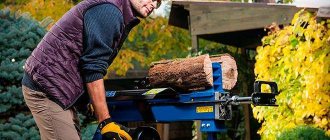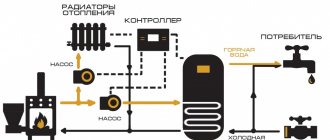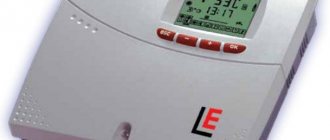To heat country cottages and private houses, combined heating boilers are increasingly being used - devices that provide optimal temperatures regardless of the presence of a centralized gas supply.
Compared to traditional equipment, combined-type units have many advantages, among which the main one is significant savings in money.
However, in order to purchase suitable equipment, you need to carefully familiarize yourself with the selection criteria and assortment.
Rating of the TOP 10 best combined boilers for heating
| Place | Model | Price |
| Models of small and medium thermal power up to 30 kW | ||
| #1 | Teplodar Kupper OVK 18 18 kW | |
| #2 | Teplodar Kupper PRO 28 28 kW | |
| #3 | ACV Delta Pro S 25 26 kW | |
| #4 | Protherm Bizon 30 NL 27.1 kW | |
| #5 | Buderus Logano G125 WS-25 25 kW | |
| High power models from 30 kW | ||
| #1 | Teplodar Kupper PRO 42 42 kW | |
| #2 | Sime 1R6 FREEST 64.8 kW | |
| #3 | Ferroli Atlas Evo 47 | |
| #4 | Sime 1R7 FREEST 74 kW | |
| #5 | Lamborghini Calor EL DB DN EVO 32 | |
Page navigation:
What are combi heating boilers?
For your information! A combined heating boiler is a device designed for heating a room that can operate on solid (wood) or diesel fuel, electricity or gas.
The equipment is universal in use, has a high efficiency and is considered very environmentally friendly .
The device is equipped with everything necessary so that it can be easily connected to a home heating system or to a “warm floor” structure - all additional accessories are usually included in the delivery package.
Principle of operation
The wood-electricity combination boiler operates according to the following algorithm :
- Melting and heating of the unit occurs in the traditional way. During the combustion of solid fuel (wood, coal, briquettes), the water temperature is maintained using a thermostat together with a sensor. Electric heating elements do not work at this moment.
- If you do not add fuel to the firebox in time, then after it burns out, the temperature of the water in the system gradually decreases to a certain value, after which a sensor is triggered, which closes the control contacts and the heating element (one or more) turns on. From this moment on, the boiler begins to operate from the mains.
- After the next loading of fuel, the water in the pipes is heated from the side of the firebox and, upon reaching the set temperature, the sensor is triggered again, but this time to turn off the heating elements. The electrical part of the boiler is again inactive until the water temperature decreases again.
Most often, the electric heater in a combination boiler is designed as an auxiliary heating device, but if you wish, you can choose a boiler model that, if necessary, can work continuously, providing hot water to the house and heating system.
A heating element with a sensor connected to a heat exchanger Source anapasunsity.ru
How to choose a combi boiler?
In order not to make a mistake in choosing a combined type device for a private home, it is worth familiarizing yourself with its main technical characteristics.
These include:
- maximum thermal power. On average, heating 1 sq.m. area you need to spend 0.1 kW of thermal energy. However, it is better to entrust the calculations to specialists who will help you find the best solution;
- fuel used. The devices are capable of working simultaneously or alternately with several types of fuel. The most popular are electric-gas, electric-wood, gas-wood, as well as models with a wood-diesel fuel combination;
- type of ignition - mechanical or electronic. According to experts, electric ignition is more economical since the unit does not have a pilot light. In addition, in the event of a short-term drop in pressure, the system will automatically resume operation of the boiler;
- heat exchanger material – steel, cast iron or copper. Steel heat exchangers withstand temperature stress well, cast iron ones have a long service life, and copper ones have high efficiency and are less susceptible to high temperatures.
Reviews of universal solid fuel boilers with built-in heating elements: advantages and disadvantages
| Advantages | Flaws |
| Only 10-15% higher cost, which makes the purchase of a combined model more profitable from a financial point of view | Quite simple functionality, lack of advanced automation |
| Partial elimination of the main drawback of TT boilers - the need for constant reloading. According to reviews from owners of even fairly large houses with an area of 150-200 m2, the power of heating elements is enough to maintain a temperature of 17-19°C until the morning. | In universal boilers for wood and electricity, only steel heat exchangers that are susceptible to corrosion are used. There are currently no cast iron models. |
| Saving space in the boiler room | Lower efficiency of heating elements |
| Possibility of using two sources of thermal energy at any time | Typically smaller firebox volume |
| Availability of dual-circuit models | Limited choice of models; foreign manufacturers are almost completely absent from the market |
| Possibility of using electricity for heating only at night at reduced rates (you need an electric meter that differentiates consumption by time zones) | The heating element block has low power and, despite the fact that it can work autonomously, is intended only to maintain temperature, and not to provide full heating |
Popular models
Keep in mind! It is easy to find suitable heating equipment on the domestic market.
The main thing is to decide in advance on the desired parameters and consider the model range in detail.
Models of small and medium thermal power up to 30 kW
TOP-5 rating of models with average power in terms of price and quality ratio.
Teplodar Kupper OVK 18 18 kW
Powerful equipment that is perfect for installation in a small room.
A combined single-circuit unit, presented in a compact housing that will not take up much space in the room.
The presence of a water-tube heat exchanger can significantly improve heat removal and increase the efficiency of the device, which are the main advantages of this model.
Specifications:
- maximum thermal power – 18 kW;
- heat exchanger material – steel;
- fuel – natural gas, coal, firewood, pellets;
- coolant temperature – 60-80 °C;
- control type – mechanical.
Advantages
- steel primary heat exchanger;
- possibility of connecting external control;
- presence of a hob;
- versatility of use;
- Convenient floor installation.
Flaws
- chimney elements will have to be purchased separately;
- lack of draft regulator included;
- complicated operating instructions.
Teplodar Kupper PRO 28 28 kW
An impressive new product, with which you no longer have to think about how to quickly heat the room.
A single-circuit model from the middle price range, which successfully implements a long-burning mode when working on coal and wood.
The device also provides the ability to install a pellet or gas burner - this allows for complete automation of the process, relieving the user of the need to constantly monitor the situation.
Specifications:
- maximum thermal power – 28 kW;
- heat exchanger material – steel;
- fuel – natural gas, coal, coal and wood briquettes, firewood, pellets;
- coolant temperature – 60-95 °C;
- control type – mechanical.
Advantages
- pre-installed thermometer;
- energy independence of equipment;
- long warranty period;
- the presence of a heating element to maintain temperature;
- extended equipment.
Flaws
- weight and dimensions of the structure;
- fast cooling;
- expensive repairs.
ACV Delta Pro S 25 26 kW
A unique model that can pleasantly surprise with its wide functionality and attractive price.
Double-circuit combi boiler designed for floor installation, ideal for both domestic and industrial purposes.
The device is distinguished by the presence of a well-thought-out system of protection against high pressure and overheating, which guarantees absolute safety of operation.
Specifications:
- maximum thermal power – 26 kW;
- heat exchanger material – stainless steel;
- fuel – natural gas, liquefied gas, diesel fuel;
- coolant temperature – 60-90 °C;
- control type – electronic.
Advantages
- power-on indication;
- presence of a thermometer and pressure gauge;
- possibility of connecting external control;
- presence of a safety valve;
- built-in boiler.
Flaws
- the burner is purchased separately;
- high cost of the model;
- It is better to invite a professional for installation.
Protherm Bizon 30 NL 27.1 kW
A highly efficient device that does not require special skills or knowledge to operate.
Single-circuit combined convection type unit, equipped with a thermometer and pressure gauge.
A nice addition was the detailed overheating protection system.
Convenience, reliability, high level of safety - the design has everything for comfortable work.
Specifications:
- maximum thermal power – 27.1 kW;
- heat exchanger material – cast iron;
- fuel – natural gas, liquefied gas, diesel fuel;
- coolant temperature – 30-90 °C;
- control type – electronic.
Advantages
- intuitive control system;
- no need for special maintenance;
- long warranty period;
- high technical characteristics;
- unobtrusive design.
Flaws
- The delivery package does not include an inflatable burner;
- slight noise during operation;
- easily dirty snow-white body.
Buderus Logano G125 WS-25 25 kW
An easy-to-use unit designed for long-term operation without breakdowns.
High-performance heating boiler, in the manufacture of which the most modern technologies were used.
The low-temperature device can be combined with gas and diesel fuel-powered fan burners.
High corrosion resistance is ensured by the use of special gray cast iron.
Specifications:
- maximum thermal power – 25 kW;
- heat exchanger material – cast iron;
- fuel – natural gas, liquefied gas, diesel fuel;
- coolant temperature – 50-90 °C;
- control type – electronic.
Advantages
- large selection of additional equipment;
- water-cooled combustion chamber;
- excellent quality of materials and workmanship;
- reasonable cost;
- good equipment.
Flaws
- no control panel provided;
- device dimensions;
- Questions for the instruction manual.
High power models from 30 kW
The best high-power models according to customer reviews and ratings.
Teplodar Kupper PRO 42 42 kW
The most powerful combined type unit, characterized by ease of maintenance and use.
One of the best-selling models on the domestic market, which has optimal thermal power and a basic mechanical control system.
To maintain the temperature for a long time, the manufacturer has added a high-power heating element to the equipment.
The combustion chamber in the device is open.
Specifications:
- maximum thermal power – 42 kW;
- heat exchanger material – steel;
- fuel – natural gas, coal, coal briquettes, firewood, pellets;
- coolant temperature – 95 °C;
- control type – mechanical.
Advantages
- ease of maintenance;
- sophisticated security system;
- clear instructions included;
- versatility of use;
- acceptable price.
Flaws
- device weight;
- Before installation, you must carefully study the instructions;
- dimensions.
Sime 1R6 FREEST 64.8 kW
A high-tech design that will be the best option for people living in private homes.
A classic heating device with an open combustion chamber, a basic electronic control system and a built-in thermometer.
The unit has high thermal power, so it is perfect for installation in large houses.
Specifications:
- maximum thermal power – 64.8 kW;
- heat exchanger material – cast iron;
- fuel – natural gas, liquefied gas, diesel fuel;
- coolant temperature – 60-90 °C;
- control type – electronic.
Advantages
- simple control system;
- reasonable cost of the device;
- expanded functionality;
- sufficient heated area;
- significant budget savings.
Flaws
- the burner will have to be purchased separately;
- noisy operation of the device;
- specific smell when first used.
Ferroli Atlas Evo 47
A superbly designed device that has absolutely everything for comfortable use.
Highly reliable and energy efficient equipment, presented in a compact case that does not take up much space.
The unit is distinguished by its operation with a low level of sound power, which means that it will definitely not cause any discomfort.
Specifications:
- maximum thermal power – 47 kW;
- heat exchanger material – steel;
- fuel – natural gas, coal, firewood, pellets;
- coolant temperature – 95 °C;
- control type – electronic.
Advantages
- excellent frost protection;
- preset display;
- closed combustion chamber;
- possibility of connecting external control;
- affordable price.
Flaws
- design for everyone;
- rather complicated instruction manual;
- Some items will have to be purchased separately.
Sime 1R7 FREEST 74 kW
A universal floor-standing unit with high technical characteristics.
Standard single-circuit model with an atmospheric combustion chamber, designed for floor installation.
The device can operate with a single-stage burner, but it is also possible to connect a climate regulator.
The warranty period for the device is one year.
Specifications:
- maximum thermal power – 74 kW;
- heat exchanger material – cast iron;
- fuel – natural gas, liquefied gas, diesel fuel;
- coolant temperature – 60-90 °C;
- control type – electronic.
Advantages
- possibility of connecting external control;
- high-quality assembly and excellent materials;
- simple and unobtrusive design;
- almost silent operation;
- clear instruction manual.
Flaws
- The delivery set does not include a burner;
- short warranty period;
- impressive design dimensions.
Lamborghini Calor EL DB DN EVO 32
An ultra-modern device, which is a prominent representative of the economical line.
Floor-mounted combination heating boiler with an ultra-modern design.
The device body is assembled from high-strength cast iron elements with a special arrangement of ribs, which ensures high efficiency and significant energy savings.
Specifications:
- maximum thermal power – 32 kW;
- heat exchanger material – cast iron;
- fuel – diesel fuel, natural and liquefied gas, waste oil, fuel oil;
- coolant temperature – 95 °C;
- control type – electronic.
Advantages
- high performance;
- innovative protection system;
- intuitive control system;
- simplified installation of the structure;
- enhanced thermal insulation.
Flaws
- expensive equipment repairs;
- increased sound power level;
- meager equipment.
Eventually
In each case, the homeowner himself decides how to organize an autonomous heating system. The proposed technical solutions will not only eliminate the unpleasant consequences of the main heater fading during severe winters, but will also provide some savings in energy resources.
The efficiency of operating solid fuel units and electric boilers in pairs has been proven by practice - the interaction of these devices provides greater comfort and guarantees reliable heat supply.
conclusions
When planning to purchase a combined heating boiler for heating a private home, you must remember that:
- the main criteria for choosing equipment are the maximum thermal power, the type of fuel used and the heat exchanger material;
- Increased attention also to the coolant temperature, control system and design dimensions ;
- For organizing one heating system, a single-circuit device would be a good solution, but if the device is also selected for hot water supply, you should give preference to a dual-circuit model.
Installation Requirements
Almost all combination boilers are manufactured in a floor-standing design and require a separately equipped boiler room. In addition, when installing them, it is necessary to comply with a number of fire and electrical safety requirements, as well as compliance with SNiPs. Below are the main installation features.
Room
- Availability of a reinforced individual foundation for installation of boiler equipment.
- Compliance with fire safety standards.
- Dryness in the boiler room, protection from moisture penetration.
- Non-combustible wall material.
- The minimum distance between the boiler and any wall is 300 mm.
Chimney
- Sealing of joints.
- No cracks or other mechanical damage.
- Insulation that prevents the formation of condensation and ice, which can lead to blockage of the chimney duct.
- The head is at least 500 mm high.
Circuit
Here it is important to eliminate the possibility of contact with water of any current-carrying elements, if any. Also a mandatory requirement is the correct selection of the cross-section of the supply wiring, which is calculated based on the total power of the equipment being powered and the current consumed.
